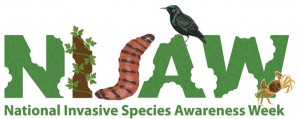National Invasive Species Awareness Week is a great opportunity for residents and visitors of Florida to learn about non-native species posing a threat to the State’s economy and environment. According to the U.S. Fish & Wildlife Service, every region of the United States is dealing with invasive species, but Florida’s invasive species problem is much more severe because the state serves as a large transportation hub for ships, planes, cruises etc.
In Florida, most people probably think of the Everglades when it comes to invasive plant and animal species, but every county in Florida deals with invasive species problems. A variety of different land management agencies spend millions of dollars every year in the control of invasive species and restoration of natural habitats. In the past I have written about Cooperative Invasive Species Management Areas or CISMAs and this is one way you as a resident or visitor in Florida can get involved in invasive species management and education efforts. You can read about CISMAs and specifically the Suncoast CISMA which includes Pinellas County here.
I will be posting on my Facebook and Twitter account all week to promote National Invasive Species Awareness Week (#NISAW). If you use social media, be sure to like or follow me and share the information on your page to help me spread the word. If social media isn’t your thing, no worries! I will share my tips for the week below:
- Learn about invasive species
- I have a couple factsheets that can be a good place to start
- If you’re into boating and hiking, make sure to clean your boats and boots, trailers and waders to prevent possibly transporting invasive species to a new area.
- If you find yourself with an unwanted pet, take advantage of opportunities like the Florida Fish and Wildlife Conservation Commission (FWC) Pet Amnesty Days.
- Despite their small size, many tiny insects are the cause of large-scale diseases outbreaks impacting important and valuable plant species. The transportation of firewood from one location to another has been found to be one way these non-native insects are introduced to different regions. If you use firewood, use locally sourced wood when permitted.
- If you’re thinking about doing some landscaping soon, make sure to check the Florida Exotic Pest Plant Council’s (FLEPPC) list of invasive plant species before making your selections. Native plants are better able to survive in their natural climate and require fewer resources to thrive.
- Help identify and report invasive species in Florida by becoming a citizen scientist. Early Dedtection & Distribution Mapping System or EDDMapS is an online and electronic system where you can report sightings of invasive species.
- Get involved with your local Suncoast CISMA or other agency working on invasive species efforts such as FWC.
There are hundreds of invasive species in Florida, but to keep from getting overwhelmed, start with your interests. If you are more of a plant person, set a goal to learn at least one of the top invasive plant species on the FLEPPC list. If you are more into animals, set a goal to learn at least one of the top invasive plant species on FWC’s page. Whichever you choose, taking steps to educate yourself about invasive species in our area is a great way to begin the process of helping to protect our natural and native resources.

Thank you for participating in National Invasive Species Awareness Week by simply reading this blog!
An Equal Opportunity Institution.
 0
0

